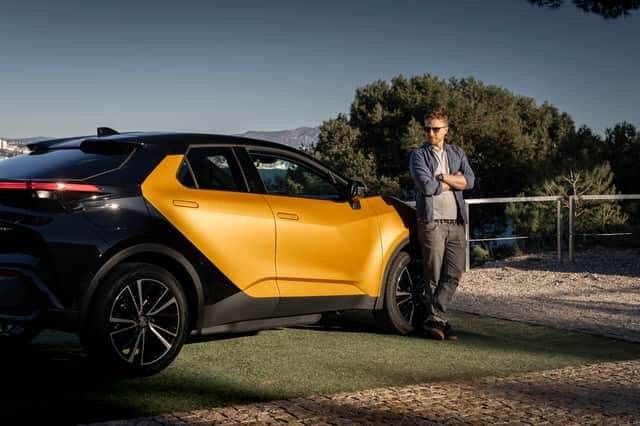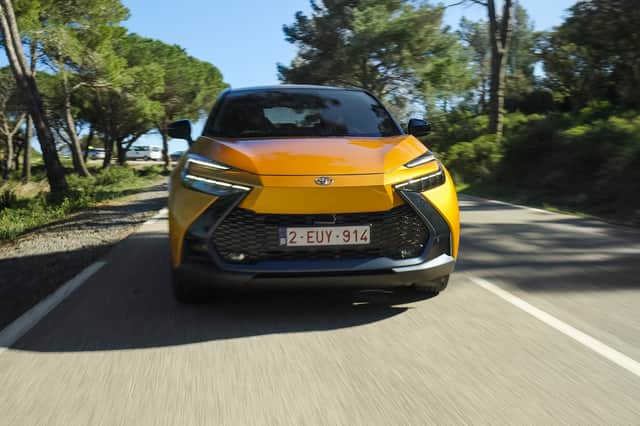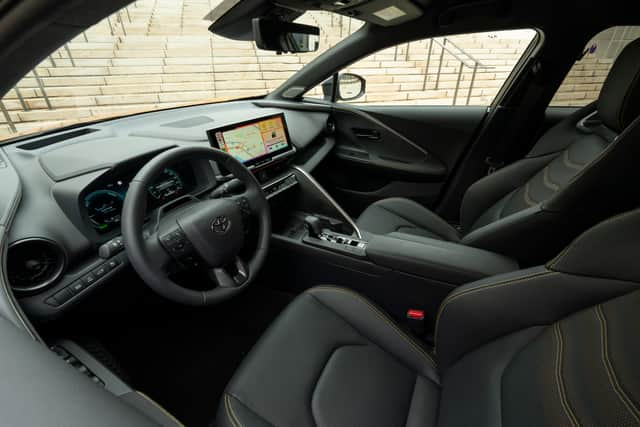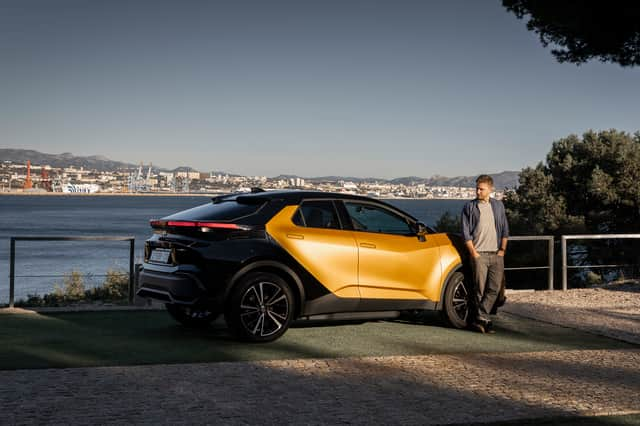I drove the Toyota C-HR PHEV in France: a Scot hasn’t looked this lost in Marseilles since the Rugby World Cup


Marseillaise on motorbikes weave dangerously fast through three lanes of traffic, white van men lean on horns and shout at each other and our sat nav frantically tries to recalculate our route as we plunge into an underground tunnel after missing yet another instruction - an off ramp, a lane change, who knows? A Scot hasn’t looked this lost in Marseilles since Gregor Townsend’s men were steamrollered 18 - 3 by the South Africans last year in the Rugby World Cup.
The urban section of my test drive of the Toyota C-HR PHEV, in the Mediterranean city of Marseilles, is a far cry from our relaxed route through the mountainous Parque Nacional de Calanques a few hours earlier. In its own way though, the scenery is just as impressive as we weave through Endoume area, skirt the old port and shoot over the motorways that bisect the France’s oldest city, all the while overlooked by giant cruise ships in the harbour and the skyscrapers of La Joliette commercial district. Whether we’re supposed to be in the vicinity of any of these places is unclear, the sat nav and my natural sense of misdirection having parted ways some time after our lunch stop at Fortin de Corbières.
Advertisement
Hide AdAdvertisement
Hide AdAs it turns out our meandering route is the perfect test for the plug-in Hybrid c-segment SUV, a Toyota fully developed for the European market, manufactured in Europe and designed with the semi-urban commute in mind.
EV-only range, charging and smart tech
The Toyota CH-R EV-only range is 41 miles which comfortably covers the average European commute of 18 miles with room to spare. The average European commuter then, able to do the office run five-days a week (or whatever variation the modern hybrid working culture has gifted them) without touching a drop of petrol or troubling the two-litre internal combustion engine, provided they are in a position to charge it regularly.
An 80 per cent charge can be achieved in around an hour via the 8KWh onboard charging capability - twice the speed of the Prius PHEV thanks to a twin charger set up.
The advantage of a plug-in hybrid of course, is the ability to balance EV-only capability with the long-range flexibility of internal combustion. Toyota’s Predictive Efficient Drive system uses geofencing technology to give customers the ability to ensure the battery is saved for the parts of the drive where the driver will get the most benefit.


Reliant on the sat nav system Predictive Efficient Drive can conserve the battery for urban stretches, like Marseilles’ low emission zone around the city centre, active since 2022, although predated by the emergency low emissions zone (which is triggered by three consecutive days of high pollution levels), which has been in effect since 2019.
The geofencing technology only works if there is a destination programmed in and doesn’t work with Apple Car Play or Android Auto. Drivers preferring to navigate via their preferred mobile device will need to either toggle the the manual ‘EV mode’ switch in the centre console or leave the system in it’s default setting, which works like any other PHEV, using the battery range until it’s gone and then reverting to internal combustion.
The transition between EV-only driving and petrol-powered combustion is almost imperceptible in most settings, the engine only becoming noticeable under duress when overtaking or navigating a relatively steep incline.
Driving experience
With 220 bhp at its disposal, the plug-in C-HR is the most powerful in the range through the combination of its 2.0-litre petrol engine and the 13.6 KWh electric motor providing power through the front axle. Pleasantly gutsy on the more rural segments of our test route where we managed to clear traffic long enough to put our foot down, nought to 62mph is achievable in 7.4 seconds, which is 0.8 seconds faster than the HEV.
Advertisement
Hide AdAdvertisement
Hide AdMore pleasant still was the handling. With improved brakes, double wishbone rear suspension and a low centre of gravity thanks, in part, to the added weight of the batteries in the floor pan, the C-HR was a delight on the meandering hillside roads surrounding the outskirts of Marseilles. During urban driving, the light steering felt agile as we negotiated warrens of narrow streets double-lined with small hatchbacks, scooters parked end-on and two-box vans abandoned at all sorts of mad angles.
The PHEV version of the C-HR features ‘B-mode’, which Toyota describes as an ‘almost one-pedal system’ but, which is in effect a regenerative braking system much like those featured in most other electric vehicles and plug-in hybrids. Capable of taking the car to within 80 per cent of a complete stop in its most assertive setting, it’s toggled on and off via a switch next to the gear selector. Changing the strength of the brakes between three different settings must be undertaken through the settings menu while the car is at a complete stop. Like the fully electric Toyota BZ4x, Toyota forgoes steering wheel mounted paddle controls for the regenerative brakes, the engineering team insisting most drivers don’t want to be mucking around with those kinds of things and prefer a simple automated set-up.
Interior and practicality
I was very conscious that the C-HR felt wider than its predecessor and consultation with the spec sheet revealed indeed that the new car has put on some girth and is 45mm wider than the outgoing model. That said, it is also slightly shorter than the old car as well, the 35mm reduction in length might just make the difference in finding a parking space in our ever more difficult to park city centres. Visibility during our not entirely intentional tour of Marseilles residential districts was tested by a series of low bollards lining some sections of pavement at the corners but, on the whole, visibility from the cabin was excellent.


Rear leg and head room felt a little cramped, the sloping roofline eating into headspace, despite the more open feeling afforded by the large panoramic sunroof in our test car. The front seat space, however, feels more spacious and comfortable, the cabin well planned out, light and airy.
The PHEV model sacrifices some boot space to accommodate the charging unit with 310 litres of space compared with 364 litres in the standard 2.0-litre and 388-litres in cars powered by the smaller 1.8-litre engine. While this still feels a reasonably flexible space, it does fall short of plug-in offerings from competitors like the Kia Niro PHEV (359 litres), Mazda MX-30 R-EV (350 litres). In the C-segment SUV category it’s fair to assume buyers will expect 300+ litres as a minimum and by that yardstick the C-HR scrapes in and ensures some clear space between models in the class below, but luggage hauling capability is unlikely to be the car’s principal selling point.
Toyota sticks with physical controls for the air conditioning, with media and infotainment functions handled via the wide-screen touch-screen interface. All driving data comes via the heads-up display and digital instrument cluster, which crams an almost overwhelming amount of information into a small screen and takes a little time to get used to.
Facts and figures
Powertrain: 2.0 plug-in hybrid electric
Price: from £39,145
Acceleration: 0-62mph in 7.4 seconds
Fuel consumption: 353mpg (WLTP)
Emissions: 19g/km
EV-only range: 41 miles
Towing capacity: 725kg
Verdict and pricing: who should buy a Toyota C-HR?
The C-HR is an interesting proposition, offering some of the perceived benefits of the C-segment SUV like raised ride height, comfort and visibility, yet prioritising cutting-edge style, aerodynamics and great driving experience over practicality. Toyota hopes it’s a winning formula and is targeting 140k sales across Europe for the model and expects 25 per cent of those to be PHEVs. Given PHEV sales only accounted for about 8 per cent of the European market in January, that’s an ambitious goal.


There are three trim levels to choose from, PHEV models not available in Toyota’s traditional entry trim of Icon. Design cars start at £39,145, while the top-spec GR Sport models push the envelope to £43,540. Sandwiched between the two is the well-equipped Excel which has fewer sporting cues than the GR Sport and a price tag of £42,610.
Advertisement
Hide AdAdvertisement
Hide AdFinance deals are competitive and, with a £4k deposit the C-HR PHEV can be charging on your driveway for £516 per month retail or £346 fleet. If we accept Toyota's definition of comparible specification, both those prices undercut the Kia Niro (in 3 spec), Cupra Formentor (V1) and Peugeot 3008 (Allure).
The 41-mile EV-only range means the C-HR joins the growing ranks of plug-in hybrid models with long enough range figures to offer a serious alternative to all electric cars for drivers that value the flexibility of a petrol engine as back up. Those buyers will only realise those benefits if they are in a position to charge the car frequently through a home charger or easy and unrestricted access to a public network.
The first generation C-HR stood out as a stylish and great-driving alternative in a segment that had been taking most of its design cues from larger than life off-roaders. With sales of over 900k since its launch in 2017, it has been a success. Since its introduction, competition in the segment has only grown fiercer, but the 2024 model puts the C-HR right out in front again as a choice for the style conscious buyer not ready to give up driving thrills in favour of extra head room.
As for my misadventures with the sat nav, the Marseillaise have a saying that translates to: ‘a man in no hurry, gets nowhere fast’. Approaching our hotel car park from the wrong side of the dual carriageway, well beyond our slated 6pm arrival time, that pearl of wisdom felt rather apt.
Comments
Want to join the conversation? Please or to comment on this article.
